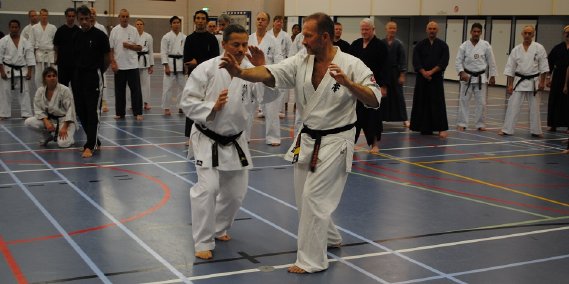

It is not necessary to abandon everything from the past, however, our understanding today should not cease to grow. There is a saying now, “If you’re doing the same thing today you were doing six months ago, you’re doing the wrong thing.” This is true in aikido. The world is changing more rapidly than ever. to his long time student of 34 years, Koji Yoshida, Shihan. Shoji Nishio, Shihan passed away on Maat the age of 77. He took O Sensei’s teaching to heart and combined it with his broad knowledge and skill resulting in a highly ethical as well as effective form of budo. He did not merely attempt to imitate the founder’s art. Nishio Sensei was not only diligent about the technical aspects of Aikido, he was faithful to Aikido’s philosophy. It seems to me that those who claim there are no weapons techniques in Aikido have not understood the founder’s words.” Nishio said that, “O Sensei said that ‘Aikido is the expression of the principles of the sword through the body.’ Therefore, understanding Aikido without first understanding the sword is quite strange. The ken (sword) and jo are central to Nishio Aikido.

For example, Nishio’s sword work is otonashi or silent, meaning the contact between blades minimal and movements are done in the gaps of the opponents attack. Nishio’s methods are thoroughly rooted in the traditional use of these weapons and are entirely different from the methods popularized by the late Morihiro Saito of Iwama. Aiki Toho Iai continues to evolve in the hands of Nishio’s successor, Koji Yoshida. Nishio Sensei developed a new form of iaido called Aikido Toho Iai which illuminates the deep relationship between the katana (Japanese sword) and techniques in Aikido. His decades of work in iaido and jodo developed into a thoroughly integrated approach to combined empty hand, sword and jo. In 1976 he was promoted to 8th dan Aikido. Even so, he personally maintained a good relationship with Hombu and with O Sensei.

His training methods, techniques, sword and jo work grew in popularity among many schools, but they were never really accepted at Hombu. Nishio Sensei found himself teaching more and more outside of Hombu Dojo. Aikido was growing in popularity and dojo’s were springing up all over in universities and companies. Atemi based on both karate and sword movements were integrated into every technique.īy 1958 Nishio has been promoted to 5th dan Aikido. He felt that it was misguided to say that Aikido could function as a martial art without using strikes. Nishio also felt that atemi (striking) was an essential aspect of any true martial art, but it was entirely absent from post-war Aikido. He remedied this with his own innovations of Aikido koshiwaza (hip throws) based on his experience in judo. For one, the number of throwing techniques done in Aikido was being limited to mainly only iriminage, shihonage, and kotegaeshi. Nishio felt that improvements were needed in other areas as well. Sometimes he would go to train and nobody would be there so he would just spend the time practicing ukemi and then go home. Nishio recalls with amusement that he was the first person to join the Kodokan after the war. There were no application forms so Nishio just wrote his name on a plain piece of paper and left it there.
KONISHI TAI SABAKI WINDOWS
When he arrived the building was a mess, windows blown out from the bombings, and no one was there but an old caretaker. The war ended Augand on September 1st he went to join the Kodokan, the world headquarters of judo. At the same time he started practicing judo in a nearby dojo. In 1942, at the age of 15, amidst the chaos of WW II, he moved to Tokyo where he began working for the Ministry of Finance in the Japanese Mint. Shoji Nishio was born in 1927 in the Aomori Prefecture of northern Japan. He received the Budo Koryusho award from the Japanese Budo Federation for his lifetime contribution to the development and advancement of Aikido throughout the world.

Shoji Nishio’s lifetime of accomplishments included numerous rankings and honors in Japanese martial arts including 8th dan in Aikido, 7th dan in Nihon Zendoku Iaido, 6th dan in Kodokan Judo, 5th dan in Shindo jinen-ryu Karate as well as training in Shindo Muso Ryu Jodo (staff) and Hozoin Ryu Yari (spear).


 0 kommentar(er)
0 kommentar(er)
